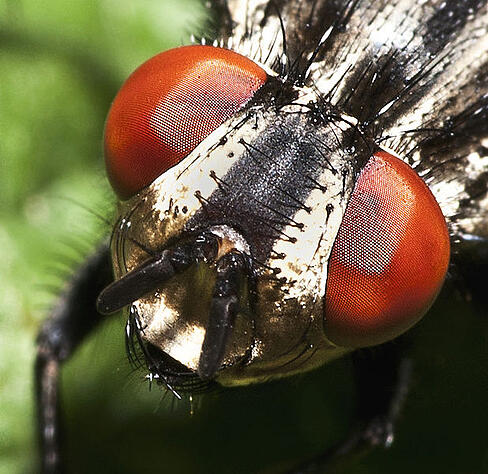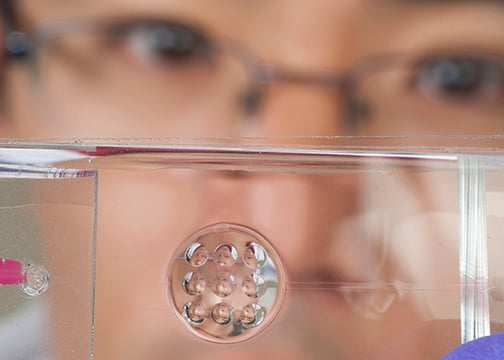With the quality of imaging for microscopes, cameras, and even smartphones increasing at a drastic rate, it takes some pretty impressive technology to make a buzz in the imaging world. This is where biotechnology steps in, fusing the creations of nature with cutting-edge technology to produce something brilliant. In this case, bioscientists at Ohio State University have created a new lens that combine the focusing ability of human eyes with the panoramic view of insect eyes.
Insects see the world through compound eyes, which means they have a multitude of small visual receptors each pointing a different way that. The result is a mosaic-like view, rather than a cohesive image. This gives insects the advantage of being able to see in more directions than, say, in front of them at any given time. The disadvantage is that they cannot see very far in any one direction. For instance, according to a Harvard biology page, “two objects that [humans] could distinguish between at 60 feet could only be discriminated by the bee at a distance of one foot.”
As the humans reading this article know, humans have the advantage of seeing much farther in a more constrained view. They can also focus on different objects, making the surrounding objects appear blurry. Digital cameras and microscopes of today can do this as well, but they have to use multiple lenses that switch in and out to give the illusion of focus. Smartphone lenses simply crop their image on all sides when told to zoom, making the resulting image grainy and pixelated.

(The compound eyes of a fly. Note the blurry background- the camera used to take this shot is focusing on the fly. Image courtesy Wikimedia Commons and Rude)
Now Ohio State University professor Yi Zhao, who specializes in biomedical engineering and ophthalmology, has made a lens that, simply put, combines the advantages of both eyes. In his words from an OSU press release, “What we get is a wide-angle lens with depth of field.” He accomplished this feat by using a dome-shaped lens that has several smaller domes placed on top of it. Each of these smaller domes is filled partly with liquid which can be transferred between the domes. The different domes collapse and expand to change the shape of the lens, much like the human eye contracts and enlarges in order to focus.
The revolutionary part of these lenses lies in their potential applications. The aforementioned multiple lenses currently used to focus could be replaced by one single, stationary lens. This would make devices like microscopes and digital cameras even lighter and reduce the need for moving parts. It could also be used in smartphones- the team’s current prototype is 5mm across, which is only slightly bigger than the average smartphone lens.

(Researcher Zhao peers at his new lens. Courtesy OSU)
These lenses could also find a place in medicine. Currently, doctors use wide-angle lenses in cameras placed inside patients to make sure they don’t miss any anomalies. “With our lens, doctors could get the wide-angle view they need, and still be able to judge the distance between the lens and tissue. They could place instruments with more confidence, and remove a tumor more easily, for example,” says Zhao.
This research was supported by graduate fellowship from the Howard Hughes Medical Institute and a Pelotonia Postdoctoral Fellowship from Ohio State’s Comprehensive Cancer Center. For more detail on the funding for research at Ohio State University, peruse our Ohio State University Funding Report:
If you are a OSU researcher or laboratory supplier, and would like to boost awareness of your products and increase scientific sales, plan to attend Biotechnology Calendar, Inc.'s next Columbus BioResearch Product Faire™, held on the Ohio State University campus. Biotechnology Calendar, Inc. has been bringing life science research trade shows to top research campuses for 20 years now. If you’d like to attend a show closer to home, please see our 2013 schedule.


